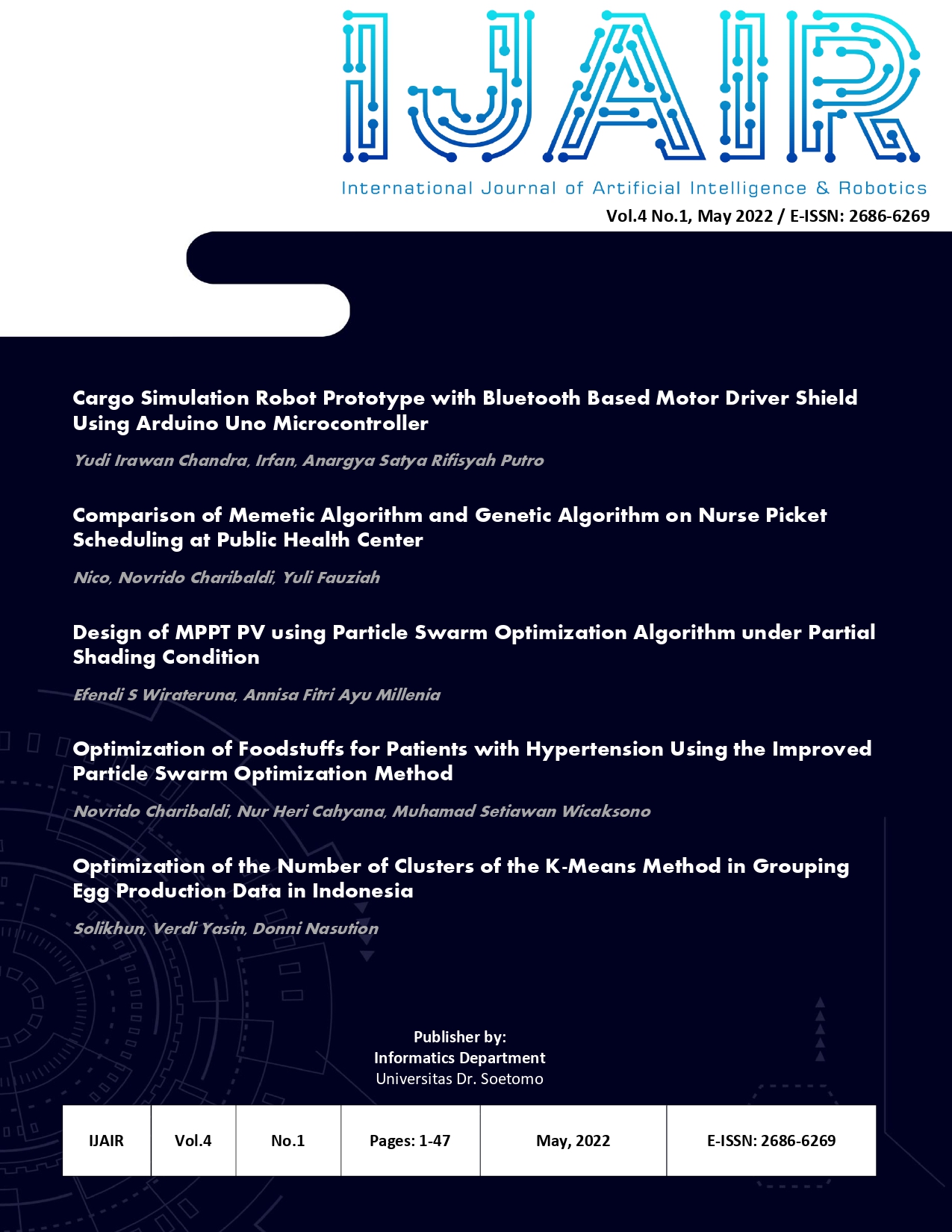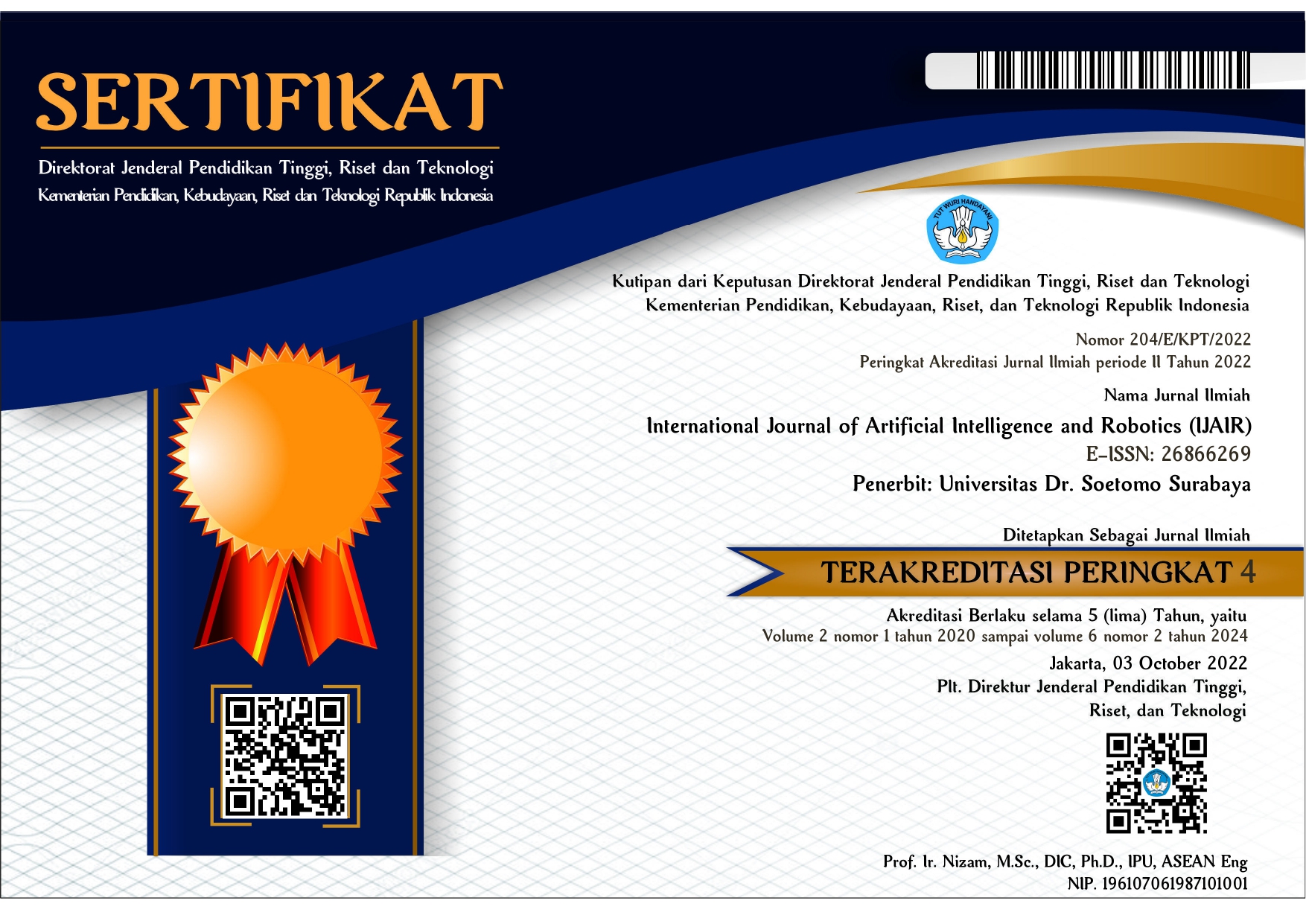Design of MPPT PV using Particle Swarm Optimization Algorithm under Partial Shading Condition
 Abstract views: 471
,
Abstract views: 471
,
 PDF downloads: 741
PDF downloads: 741
Abstract
Fossil energy sources experience a decrease each year when the demand increases significantly. In the case of environmental issues, renewable energy sources (RES) can be energy alternatives. The photovoltaic module is RES with unique characteristics, especially partial shading conditions. This condition leads to the PV characteristic curve experiencing multiple peaks. The paper conducted the simulation of the PV solar panel module using MATLAB Simulink. The Maximum Power Point Tracking (MPPT) PV is also described based on a particle swarm optimization (PSO) algorithm. The proposed algorithm can address multiple peak curve problems due to partial shading conditions. For comparison, the conventional algorithm, perturb & observe, is presented. The PV module is divided into three group cells with irradiance differences for each group to illustrate the partial shading condition. The result shows that the PSO algorithm guarantees optimal and fast response for the operating PowerPoint. It needs about 0.04 seconds to maintain at the optimal power point, 129 Watt, compared with the perturb and observe algorithm performance that only kept at the lower operating power point, 67 Watt at 0.06 second. Thus, the PSO algorithm can tackle the partial shading condition with a fast response to maintain the maximum PowerPoint. Therefore, the PSO algorithm is the proper solution for tracking the optimum operating power point under partial shading conditions.
Downloads
References
A. Shahsavari and M. Akbari, “Potential of solar energy in developing countries for reducing energy-related emissions,†Renewable and Sustainable Energy Reviews, vol. 90, no. C, pp. 275–291, 2018, [Online]. Available: https://EconPapers.repec.org/RePEc:eee:rensus:v:90:y:2018:i:c:p:275-291
V. S. Arutyunov and G. v Lisichkin, “Energy resources of the 21st century: problems and forecasts. Can renewable energy sources replace fossil fuels?,†Russian Chemical Reviews, vol. 86, no. 8, pp. 777–804, Aug. 2017, doi: 10.1070/rcr4723.
B. Liu, C. Fu, A. Bielefield, and Y. Q. Liu, “Forecasting of Chinese Primary Energy Consumption in 2021 with GRU artificial neural network,†Energies (Basel), vol. 10, no. 10, Oct. 2017, doi: 10.3390/en10101453.
A. Nur Nazilah Chamim et al., “Analysis of Potential Alternative Energy Sources for Electricity Conservation in Yogyakarta State Finance Building,†Journal of Electrical Technology UMY (JET-UMY), vol. 3, no. 3, 2019.
K. Vansant et al., “INVESTIGATION OF CORRELATION BETWEEN FIELD PERFORMANCE AND INDOOR ACCELERATION MEASUREMENTS OF POTENTIAL INDUCED DEGRADATION (PID) FOR C-SI PV MODULES,†2017. [Online]. Available: https://www.researchgate.net/publication/330398059
Y. Chaibi, M. Salhi, A. El-jouni, and A. Essadki, “A new method to extract the equivalent circuit parameters of a photovoltaic panel,†Solar Energy, vol. 163, pp. 376–386, 2018, doi: https://doi.org/10.1016/j.solener.2018.02.017.
A. Chalh, A. el Hammoumi, S. Motahhir, A. el Ghzizal, U. Subramaniam, and A. Derouich, “Trusted simulation using proteus model for a PV system: Test case of an improved HC MPPT algorithm,†Energies (Basel), vol. 13, no. 8, Apr. 2020, doi: 10.3390/en13081943.
Q. Zhu, X. Zhang, S. Li, C. Liu, and H. Ni, “Research and Test of Power-Loop-Based Dynamic Multi-Peak MPPT Algorithm,†IEEE Transactions on Industrial Electronics, vol. 63, no. 12, pp. 7349–7359, 2016, doi: 10.1109/TIE.2016.2594233.
S. Motahhir, A. Chalh, A. el Ghzizal, S. Sebti, and A. Derouich, “Modeling of photovoltaic panel by using proteus,†Journal of Engineering Science and Technology Review, vol. 10, no. 2, pp. 8–13, 2017, doi: 10.25103/jestr.102.02.
A. Chalh, A. el Hammoumi, S. Motahhir, A. el Ghzizal, U. Subramaniam, and A. Derouich, “Trusted simulation using proteus model for a PV system: Test case of an improved HC MPPT algorithm,†Energies (Basel), vol. 13, no. 8, Apr. 2020, doi: 10.3390/en13081943.
E. Bas, E. Egrioglu, and E. Kolemen, “Training simple recurrent deep artificial neural network for forecasting using particle swarm optimization,†Granular Computing, vol. 7, no. 2, pp. 411–420, 2022, doi: 10.1007/s41066-021-00274-2.
N. Setyawan, E. A. Hakim, and Z. Zulfatman, “SIGNATURE PSO: MODIFIED PARTICLE SWARM OPTIMIZATION DENGAN FUZZY SIGNATURE DAN IMPLEMENTASI PADA OPTIMALISASI KENDALI LQR,†MULTITEK INDONESIA, vol. 13, no. 2, p. 29, Jan. 2020, doi: 10.24269/mtkind.v13i2.2227.
Copyright (c) 2022 Efendi S Wirateruna; Annisa Fitri Ayu Millenia

This work is licensed under a Creative Commons Attribution-ShareAlike 4.0 International License.
Authors who publish with International Journal of Artificial Intelligence & Robotics (IJAIR) agree to the following terms:
-
Authors retain copyright and grant the journal right of first publication with the work simultaneously licensed under a Creative Commons Attribution License (CC BY-SA 4.0) that allows others to share the work with an acknowledgment of the work's authorship and initial publication in this journal.
-
Authors are able to enter into separate, additional contractual arrangements for the non-exclusive distribution of the journal's published version of the work (e.g., post it to an institutional repository or publish it in a book), with an acknowledgment of its initial publication in this journal.
-
Authors are permitted and encouraged to post their work online (e.g., in institutional repositories or on their website) prior to and during the submission process, as it can lead to productive exchanges, as well as earlier and greater citation of published work.















